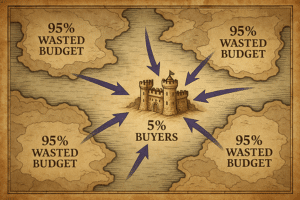🎥 [Watch the replay of the session “Why your MQLs are no longer enough”]
Video chapters
- 00:00:52 You’ve invested in marketing automation… but is it enough?
- 00:03:40 The funnel problem
- 00:08:24 Limit 1: Volume
- 00:10:07 Limit 2: MQLs arrive too late
- 00:13:47 Limit 3: Sales and marketing not aligned
- 00:14:36 The necessary transition to ABM
- 00:16:29 Lead Funnel vs Account Funnel
- 00:20:05 Key ABM concepts
- 00:22:07 ABM + Marketing Automation
Below is the Miro board used in Marketing Office Hours. It contains links to other boards used
You’ve invested in marketing automation… but is it enough?
You’ve deployed Marketo, built your nurturing scenarios, set up your scoring, and aligned your campaigns.
Your reports show rising MQLs, and your workflows are running like clockwork.
Well done
But is that really enough to generate business?
Not quite.
Most B2B marketing departments face the same problem: despite a well-stocked lead pipeline, sales are struggling to convert. This is the current marketing department blues.
And it’s not a technical execution problem: it’s a model problem.
The problem with the traditional funnel
The classic funnel (Visitor → Lead → MQL → SQL → Opportunity) was designed to simplify an overly complex reality. And we made the convenient assumption that purchasing decisions were linear and individual.
Suddenly, it was easier to
- create tracking indicators
- evaluate marketing and set objectives
And the “model became reality” in many companies: exclusive focus on MQLs, volume targets, and intense pressure when quotas were not met.
However, modern B2B has never worked this way (except in the case of the startup market, and even then…).
Today, a B2B purchase involves several decision-makers, often from different departments, and 70% of the purchasing process takes place without direct contact with your teams.
The result:
- The marketing lead (MQL) represents only a fraction of the account,
- And the traditional funnel no longer reflects the reality of the purchasing journey.
Limitation #1: Too much volume, not enough focus
Marketing automation has made it possible to generate lots of leads. Too many, sometimes.
Hundreds of MQLs are generated, but only a handful are truly strategic accounts.
This discrepancy creates noise: sales teams spend their time sorting through leads instead of focusing on the right accounts.
“We have too many MQLs and not enough customers.”
This is a phrase often heard in organizations with mature marketing automation programs.
Limitation #2: MQLs arrive too late
“80% of buyers choose a brand they already know” (The Day One List Bain & Company)
When a prospect reaches the MQL scoring threshold, they are often already well advanced in their journey.
Signs of interest (search intentions, visits to key pages, social interactions) have been visible for weeks, but have not been exploited.
The result: marketing reacts instead of anticipating.
Buyers have already shortlisted their options or even chosen a competitor.
You are entering the discussion too late.
Limitation #3: Lack of alignment between marketing and sales
Sales says: “These leads are not good.”
Marketing responds: “But they meet our MQL criteria.”
Both are right.
The problem is that each is working on a different logic:
- Marketing thinks in terms of individual leads,
- Sales thinks in terms of accounts and opportunities.
This structural misalignment explains why the MQL → opportunity conversion rate remains low despite all the automation efforts.
The necessary transition to ABM
This is where Account-Based Marketing (ABM) comes in.
ABM offers a radically different approach: moving from leads to accounts.
Rather than seeking to generate more and more leads, the focus is on:
- Strategic accounts (those that really matter to the business),
- Signals of intent, to detect the right moment for action,
- And orchestration between marketing and sales to deliver the right message to the right people.
Lead funnel vs. account funnel
In a lead-based funnel, each contact progresses alone.
In an account-based funnel, it is the entire account that progresses through the journey.
| Lead-Based Approach | Account-Based Approach |
| Unit = individual | Unit = account |
| Objective = volume | Objective = relevance |
| Individual scoring | Collective scoring (Intent + Engagement) |
| Marketing pushes leads | Marketing and sales work together |
| Measurement = MQL | Measurement = account progression |
This shift changes everything: marketing becomes a strategic partner in business development.
Key ABM concepts
1. Target Account List (TAL)
A list of priority accounts defined jointly with sales.
2. Intent Data
Analysis of search signals to detect accounts “in the market.”
3. Buying Groups
Identify, map, and engage purchasing committees collectively.
4. Personalization
Tailor messaging and campaigns to the reality of each account.
ABM + Marketing Automation: A Powerful Combination
Good news: everything you’ve built with your marketing automation tool (Marketo, Eloqua, HubSpot, etc.) remains useful.
ABM doesn’t replace your existing stack: it guides and reinforces it.
- Marketing Automation = the execution engine (nurturing, email, campaigns, scoring)
- ABM = the navigation system (targeting, timing, alignment, strategy)
Marketo + ABM is like a powerful engine with smart GPS.
By combining the two, you move from volume-oriented marketing to value-oriented marketing.
In conclusion
Your MQLs aren’t dead, but they need to evolve
MQLs remain a useful indicator, but they can no longer be the sole compass for B2B marketing.
What matters now is the progress of strategic accounts in their buying cycle.
That’s the point of this new Marketing Office Hours series: to help marketers move from volume-driven to value-driven management.





